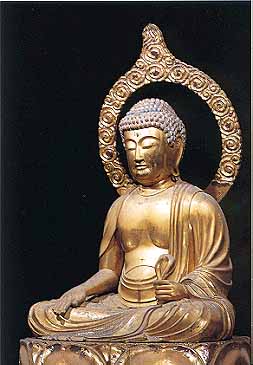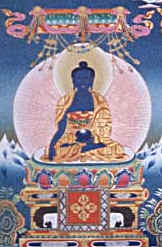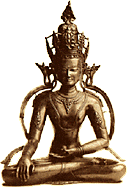|
 The name Akshobhya (Aksobhya) means " Immovable " or " Unshakable."
The name Akshobhya (Aksobhya) means " Immovable " or " Unshakable."
In Chinese he is called Ah-Chu-For.
In Japanese he is called Ashuku Nyorai. (Fig 1)
In Tibetan he is called Mi Kyu Pa, or Sang Gye. (Fig 2 & 3)
He is a principal buddha within Vajrayana Buddhism residing in the eastern quarter of a mandala, surrounded by numerous forms of Green and White Tara. He is found throughout all four tantra classifications most notably in the Anu-yoga class. His consort is Lochana, and they represent the Tathagata family, space and all encompassing wisdom.
Akshobhya is also mentioned in several Mahayana sutras, the
Vimalakirti Nirdesa being the most famous.
 Akshobhya symbolizes the overcoming of passions. This buddha originates from
the blue mantra "Hum" and reigns over the eastern paradise - Abhirati,
the Land of Exceeding Great Delight. It is believed that whoever is reborn
there can never fall back to a lower level of consciousness,
thus all believers should seek to fulfill the promise kept by Akshobhya.
Akshobhya's bija is Hum and his mantra is Om Akshobhya Hum.
Akshobhya symbolizes the overcoming of passions. This buddha originates from
the blue mantra "Hum" and reigns over the eastern paradise - Abhirati,
the Land of Exceeding Great Delight. It is believed that whoever is reborn
there can never fall back to a lower level of consciousness,
thus all believers should seek to fulfill the promise kept by Akshobhya.
Akshobhya's bija is Hum and his mantra is Om Akshobhya Hum.
 Akshobhya as a monk is said to have taken a vow before the buddha who,
endlessly long ago, reigned over Abhirati, never to feel disgust or
anger towards any being. In carrying out this vow, he showed himself
"immovable" and after endlessly long striving became Buddha Akshobhya
and thereby the ruler of the Abhirati paradise.
According to the sutras,"He arising in the eastern direction on an elephant,
lotus and moon throne; with a body blue in color and the right hand is placed in the bhumisparsha (earth-touching) mudra." This mudra with the fingers pressing against the ground represents the enlightenment commitment by calling the earth to commemorate Sakyamuni Buddha's victory over temptation by the Evil One, Mara. Akshobhya's left hand placed palm upward in the lap performs the mudra of meditation.
Akshobhya as a monk is said to have taken a vow before the buddha who,
endlessly long ago, reigned over Abhirati, never to feel disgust or
anger towards any being. In carrying out this vow, he showed himself
"immovable" and after endlessly long striving became Buddha Akshobhya
and thereby the ruler of the Abhirati paradise.
According to the sutras,"He arising in the eastern direction on an elephant,
lotus and moon throne; with a body blue in color and the right hand is placed in the bhumisparsha (earth-touching) mudra." This mudra with the fingers pressing against the ground represents the enlightenment commitment by calling the earth to commemorate Sakyamuni Buddha's victory over temptation by the Evil One, Mara. Akshobhya's left hand placed palm upward in the lap performs the mudra of meditation.
Akshobhya rules over the element of water and personifies the skandha of form. In some systems, he is associated with the skandha of consciousness. His lotus throne is supported by the elephant, which represents steadfastness and strength. His symbol is the vajra, which denotes enlightenment, the indestructible, adamantine nature of pure consciousness, or the essence of Reality. In some traditions the vajra signifies the union of man and the Buddha; one end of the vajra symbolizes the macrocosmic realm (the Buddha) and the other end the microcosmic realm (man).
|
 The name Akshobhya (Aksobhya) means " Immovable " or " Unshakable."
The name Akshobhya (Aksobhya) means " Immovable " or " Unshakable."  Akshobhya symbolizes the overcoming of passions. This buddha originates from
the blue mantra "Hum" and reigns over the eastern paradise - Abhirati,
the Land of Exceeding Great Delight. It is believed that whoever is reborn
there can never fall back to a lower level of consciousness,
thus all believers should seek to fulfill the promise kept by Akshobhya.
Akshobhya's bija is Hum and his mantra is Om Akshobhya Hum.
Akshobhya symbolizes the overcoming of passions. This buddha originates from
the blue mantra "Hum" and reigns over the eastern paradise - Abhirati,
the Land of Exceeding Great Delight. It is believed that whoever is reborn
there can never fall back to a lower level of consciousness,
thus all believers should seek to fulfill the promise kept by Akshobhya.
Akshobhya's bija is Hum and his mantra is Om Akshobhya Hum.
 Akshobhya as a monk is said to have taken a vow before the buddha who,
endlessly long ago, reigned over Abhirati, never to feel disgust or
anger towards any being. In carrying out this vow, he showed himself
"immovable" and after endlessly long striving became Buddha Akshobhya
and thereby the ruler of the Abhirati paradise.
According to the sutras,"He arising in the eastern direction on an elephant,
lotus and moon throne; with a body blue in color and the right hand is placed in the bhumisparsha (earth-touching) mudra." This mudra with the fingers pressing against the ground represents the enlightenment commitment by calling the earth to commemorate Sakyamuni Buddha's victory over temptation by the Evil One, Mara. Akshobhya's left hand placed palm upward in the lap performs the mudra of meditation.
Akshobhya as a monk is said to have taken a vow before the buddha who,
endlessly long ago, reigned over Abhirati, never to feel disgust or
anger towards any being. In carrying out this vow, he showed himself
"immovable" and after endlessly long striving became Buddha Akshobhya
and thereby the ruler of the Abhirati paradise.
According to the sutras,"He arising in the eastern direction on an elephant,
lotus and moon throne; with a body blue in color and the right hand is placed in the bhumisparsha (earth-touching) mudra." This mudra with the fingers pressing against the ground represents the enlightenment commitment by calling the earth to commemorate Sakyamuni Buddha's victory over temptation by the Evil One, Mara. Akshobhya's left hand placed palm upward in the lap performs the mudra of meditation.